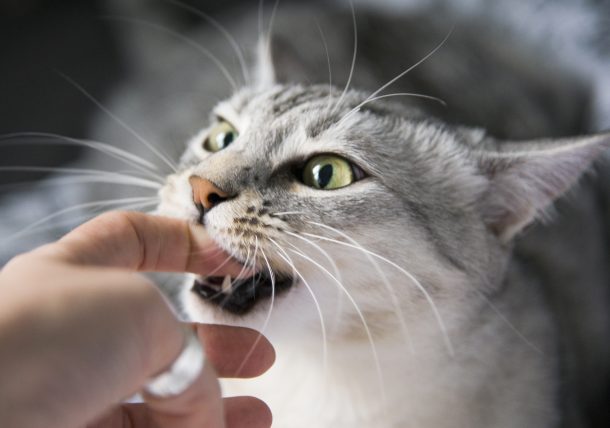Feline Love Bites

“I don’t always want belly rubs, but when I do, I want EXACTLY three.” —My cat
Have you ever sat absentmindedly gazing at a screen while stroking a rolling, purring, drooling, absolutely content lap cat only to be suddenly and inexplicably nipped? Have you ever petted a fuzzy friend who decided to grab your hands gently with both paws to lick and kiss only to find they have been tenderizing you for a chomp? You aren’t the first and certainly won’t be the last to experience these feline phenomena.
How to Properly Pet Cats
Most cats love to be stroked, but they are particular about how they want to be touched. Even when cats approach for cuddles, it needs to be on their terms and stopped at their preference. Always pet in the direction of fur growth and watch for cues that indicate they are overstimulated. Cats tell us when enough is enough, but it takes experience to read the signs.
Monitor the kitty for slow tail flicking, flattening of their ears or dilation of their pupils. By the time they hiss, it’s often too late; they may swat or “love bite.” Usually these inhibited bites cause no harm and serve as a warning to stop the interaction. It’s your job to read the language and stop before they reach their limit. Some cats prefer gentle scratches on the head, chin and neck to long strokes along the back or tail.
Some Cats Are Overly Sensitive to Touch
It’s possible cats are similar to ticklish people. Ticklish people don’t enjoy being tickled, as the stimulation is overwhelming. Cats with hyperesthesia, which is an abnormally increased sensitivity of the skin, or the more serious Feline Hyperesthesia Syndrome don’t enjoy excessive handling; it can actually be very uncomfortable or even painful for these cats. Sometimes they prefer the gentle contact of sitting in a lap without being touched. You can condition these cats to accept petting by stopping before the irritation threshold is reached and positively rewarding pleasant interactions with treats while gradually increasing the time of the interaction and number of strokes.
How to Correct Misdirected Play Behavior
Misdirected play behavior also can be mistaken for a “love bite.” Cats under 2 years, especially cats that spend much of the day alone, may exhibit predatory play behavior, which includes stalking their prey, namely you. They may run and chase before an attack and then hide behind household objects, often with a tail or a rear sticking out in plain view. This normal play behavior occurs when a kitten or young cat bites or attacks moving limbs, like a hand when you reach to pet them or your foot as you walk into the kitchen. This attack is not preceded by aggressive behavior such as growling or piloerectionwhen stress hormones cause small muscles in the skin along the hair follicles to contract, thereby raising the hairs upwards away from the skin causing a classic ‘Halloween’ cat appearance. Most often occurs along the shoulders, back and tail, but sometimes some play vocalizations will be noted. To help cats differentiate what is and is not appropriate behavior in your home, avoid using your hands for any kind of play. Instead, opt for toys on a wand, throwing soft toys or using laser pointers so the object of their play is inanimate and cannot feel their crushing fury as they exert all their superior kitten might into shredding it into a million pieces. Make sure to give your young cat clicker training or daily play time to avoid escalation of these behaviors.
Cats are quirky, affectionate creatures that we are lucky to share our homes with. Love your cats while respecting their boundaries. Give them the interaction they need, be it play time or lap time, to cultivate a rewarding companionship.
References:
The Feline Patient, 5th Ed. G. Norsworthy. Wiley Blackwell.
Kira Ramdas, DVM, is a graduate of Texas A&M College of Veterinary Medicine and lives in The Woodlands, Texas. Dr. Ramdas practices at Just Cats Veterinary Services.

